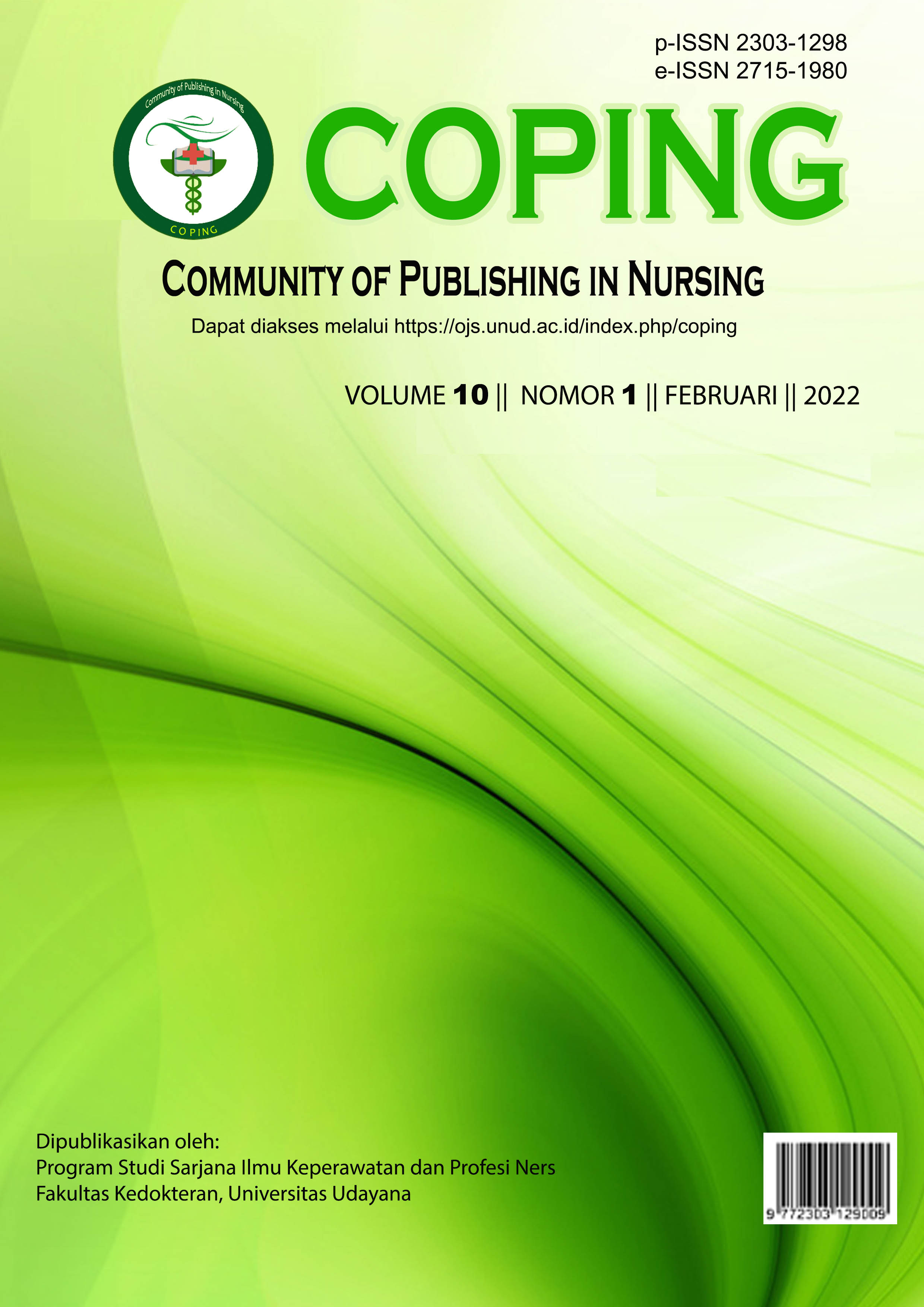ACTIVE LOWER RANGE OF MOTION BERBANTU KAYU REFLEKSI MENINGKATKAN KELEMBABAN KAKI PASIEN DIABETES MELITUS TIPE II
Abstract
Sudomotor autonomic neuropathy decrease the function of the sweat glands (eccrine) so that the skin of the foot becomes dry and cracked may predispose the diabetic foot. This study aimed to determine the effect of active lower range of motion assisted by wooden reflexology roller on the foot moisture of diabetic patient. In this quasi-experimental research with pre and post-test design with the control group, 36 diabetic patients with T2DM ?3 years, aged ?50 years, and did not have diabetic or gangrenous ulcers were grouped into the treatment group, which was given an active lower range of motion assisted by wooden reflexology roller, and the control group, which was given standard treatment. The average humidity of the treatment group increased from 24.75% to 43.48% with the p-value 0,000 (? = 0,05). While the control group’s feet moisture increased from 27.1% to 32.4% with a p-value 0.000. The p-value of independent sample t-test between treatment group and control resulted 0,000 (? = 0,05). According to the results, it can be concluded that there was a significant influence between active role ROM assisted wood reflection and the moisture of DM type II patient's feet.
Downloads
References
Boulton, A. J. M. (2005). Management of Diabetic Peripheral Neuropathy. Clinical Diabetes, 23(1), 9–15.
Colberg, S. R., Sigal, R. J., Fernhall, B., Regensteiner, J. G., Blissmer, B. J., Rubin, R. R., Chasan-Taber, L., Albright, A. L., & Braun, B. (2010). Exercise and type 2 diabetes: The American College of Sports Medicine and the American Diabetes Association: Joint position statement. Diabetes Care, 33(12). https://doi.org/10.2337/dc10-9990
Ganong, W. . (2008). Buku Ajar Fisiologi Kedokteran (22nd ed.). EGC.
Indriani, P., Supriyatno, H., & Santoso, A. (2004). Pengaruh Latihan Fisik; Senam Aerobik Terhadap Penurunan Kadar Gula Darah pada Penderita DM Tipe 2 di Wilayah Puskesmas Bukateja Purbalingga. Media Ners, 1(2), 89–99. https://doi.org/10.14710/NMJN.V1I2.717
International Diabetes Federation. (2017). Eighth Edition.
Morgeson, F. P., Aguinis, H., Waldman, David, A., & Sengiel, Donald, S. (2013). A device to measure secretion of individual sweat glands for diagnosis of peripheral neuropathy. Personnel Psychology, 1–29. https://doi.org/10.1111/peps.12055.This
Rahmawati, A., & Hargono, A. (2018). Faktor Dominan Neuropati Diabetik pada Pasien DM Tipe II di RSUD Dr. Soewandhi Surabaya. Jurnal Berkala Epidemiologi, 6(1), 78–89. https://doi.org/10.20473/jbe.v6i1.2018.
Shibasaki, M., & Crandall, C. G. (2010). Mechanisms and controllers of eccrine sweating in humans. Frontiers in Bioscience (Scholar Edition), 2(69), 685–696. https://doi.org/10.2741/s94
Shivaprasad, C., Amit, G., Anish, K., Rakesh, B., Anupam, B., & Aiswarya, Y. (2018). Clinical correlates of sudomotor dysfunction in patients with type 2 diabetes and peripheral neuropathy. Diabetes Research and Clinical Practice. https://doi.org/10.1016/j.diabres.2018.03.004
Sliz, D., Smith, A., Wiebking, C., Northoff, G., & Hayley, S. (2012). Neural correlates of a single-session massage treatment. Brain Imaging and Behavior, 6(1), 77–87. https://doi.org/10.1007/s11682-011-9146-z
Smeltzer, S. C., & Bare, B. G. (2008). Buku Ajar Keperawatan Medikal Bedah Volume 2 (8th ed.). EGC.
Suari, P. W. (2015). Pengaruh Pemberian Active Lower Rom Terhadap Perubahan Nilai Ankle Brachial Index Pasien DM Tipe 2 Di Wilayah Puskesmas II Denpasar Barat. Jurnal Ilmu Keperawatan FK Unud, 3(1).
Sunarto, N. (2012). Edukasi Penanggulangan Bencana Lewat Sekolah. http://bpbd.banjarkab.go.id
Tentolouris, N., Voulgari, C., Liatis, S., Kokkinos, A., Eleftheriadou, I., Makrilakis, K., Marinou, K., & Katsilambros, N. (2010). Moisture Status of the Skin of the Feet Assessed by the Visual Test Neuropad Correlates With Foot Ulceration in Diabetes. Diabetes Care, 33(5), 1112–1114. https://doi.org/10.2337/dc09-2027
Widyawati, I. Y., Irawaty, D., & Sabri, L. (2010). Active Lower Range of Motion Reduce the Sign and Symptom of Diabetic Neuropathy. Ners, 5(2), 107–117.
Yuwono, P., Khoiriyati, A., & Sari, N. K. (2015). Pengaruh Terapi Pijat Refleksi Kaki Terhadap Ankle Brachial Index (ABI) pada Pasien Diabetes Melitus Tipe 2. Journal of Nursing Science, 10(20), 53–64.







